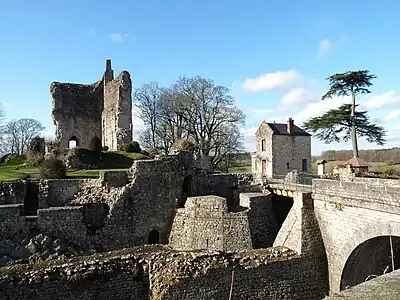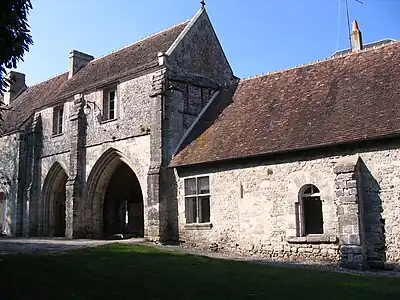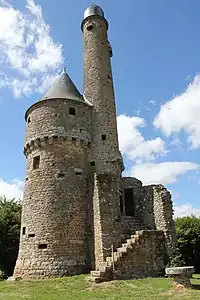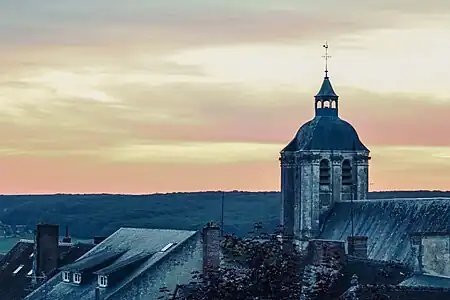Orne
Orne (French pronunciation: [ɔʁn] ⓘ; Norman: Ôrne or Orne) is a département in the northwest of France, named after the river Orne. It had a population of 279,942 in 2019.[3]
Orne | |
|---|---|
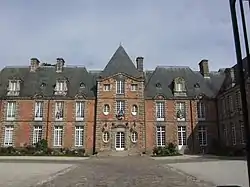 Prefecture building of the Orne department, in Alençon | |
 Flag  Coat of arms | |
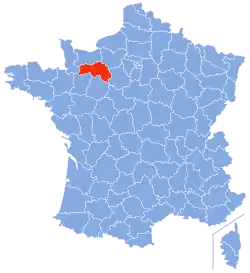 Location of Orne in France | |
| Coordinates: 48°42′N 0°0′E | |
| Country | France |
| Region | Normandy |
| Prefecture | Alençon |
| Subprefectures | Argentan Mortagne-au-Perche |
| Government | |
| • President of the Departmental Council | Christophe de Balorre[1] |
| Area | |
| • Total | 6,103 km2 (2,356 sq mi) |
| Population | |
| • Total | 278,475 |
| • Rank | 78th |
| • Density | 46/km2 (120/sq mi) |
| Time zone | UTC+1 (CET) |
| • Summer (DST) | UTC+2 (CEST) |
| Department number | 61 |
| Arrondissements | 3 |
| Cantons | 21 |
| Communes | 385 |
| ^1 French Land Register data, which exclude estuaries, and lakes, ponds, and glaciers larger than 1 km2 | |
History
Orne is one of the original 83 départements created during the French Revolution, on 4 March 1790. It was created from parts of the former provinces of Normandy and Perche. It is the birthplace of Charlotte Corday, Girondist and the assassin of Jean-Paul Marat.
Geography
Orne is in the region of Normandy neighbouring Eure, Eure-et-Loir, Sarthe, Manche, Mayenne, and Calvados. It is the only department of Normandy not to border the English Channel.
Economy
The largest town by a considerable margin is the prefecture, Alençon, which is an administrative and commercial centre for what is still an overwhelmingly rural department. There are no large industrial centres, and agriculture remains the economic focus.
Demographics
|
| ||||||||||||||||||||||||||||||||||||||||||||||||||||||||||||||||||||||||||||||||||||
| Sources:[4][5] | |||||||||||||||||||||||||||||||||||||||||||||||||||||||||||||||||||||||||||||||||||||
The inhabitants of the department are called Ornais.
The recorded population level peaked at 443,688 in 1836. Declining farm incomes and the lure of better prospects in the overseas empire led to a sustained reduction in population levels in many rural departments. By the time of the 1936 census, the recorded population stood at just 269,331. Once motor car ownership started to surge in the 1960s, employment opportunities became less restricted and by 1982, the population level had recovered a little to 295,000, after which it slowly decreased.
Politics
The president of the Departmental Council is Christophe de Balorre, elected in 2017.
Presidential elections 2nd round
| Election | Winning Candidate | Party | % | 2nd Place Candidate | Party | % | |
|---|---|---|---|---|---|---|---|
| 2022[6] | Emmanuel Macron | LREM | 55.12 | Marine Le Pen | RN | 44.88 | |
| 2017 | Emmanuel Macron | LREM | 61.64 | Marine Le Pen | FN | 38.36 | |
| 2012 | Nicolas Sarkozy | UMP | 52.89 | François Hollande | PS | 47.11 | |
| 2007 | Nicolas Sarkozy | UMP | 57.66 | Ségolène Royal | PS | 42.34 | |
| 2002[7] | Jacques Chirac | RPR | 81.30 | Jean-Marie Le Pen | FN | 18.70 | |
Current National Assembly Representatives
| Constituency | Member[8] | Party | |
|---|---|---|---|
| Orne's 1st constituency | Joaquim Pueyo | Socialist Party | |
| Orne's 2nd constituency | Véronique Louwagie | The Republicans | |
| Orne's 3rd constituency | Jérôme Nury | The Republicans | |
Culture
Alençon is the chief town of the Orne department.
Camembert, the village where Camembert cheese is made, is located in Orne.
The local dialect is known as Augeron.
Tourism
See also
References
- "Répertoire national des élus: les conseillers départementaux". data.gouv.fr, Plateforme ouverte des données publiques françaises (in French). 4 May 2022.
- "Téléchargement du fichier d'ensemble des populations légales en 2020". The National Institute of Statistics and Economic Studies. 29 December 2022.
- Populations légales 2019: 61 Orne, INSEE
- "Historique de l'Orne". Le SPLAF.
- "Évolution et structure de la population en 2016". INSEE.
- "Résultats élections: Orne". Le Monde.
- "Résultats de l'élection présidentielle 2002: Orne". Ministère de l'Intérieur.
- Nationale, Assemblée. "Assemblée nationale ~ Les députés, le vote de la loi, le Parlement français". Assemblée nationale.
External links
- (in French) Prefecture website
- (in French) Departmental Council website
- (in English) Orne at Curlie
- (in English) Orne Tourism
- (in English) AWOL in the Orne, in 1918 Life in the Orne, WW1 with images

